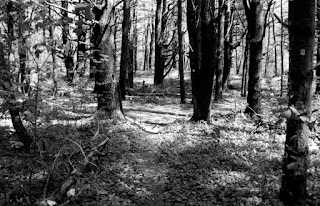
(You might hear a fisher cat in a dense forest like Marshfield’s Corn Hill Woodland.)
Have you ever heard of fisher cats? Until recently, I hadn’t. And then all of a sudden everyone seemed to be talking about them. According to the Massachusetts Audubon Society, fisher cat sightings “have increased significantly since 2000, especially in eastern Massachusetts.”
The fisher cat (Martes pennanti) isn’t really a cat. Nor does it fish. A member of the weasel (mustelid) family, it gets its name from its similarity in size and shape to a house cat, only it has shorter legs and a longer snout . . . or because it is often found stalking mice around barns. On the other hand, some say the fisher cat gets its name from the way it “fishes” for housecats that wander in the woods. And still others say its name is derived from the French word for weasel, “fissau,” which was anglicized into “fisher.”
The fisher cat has a thick, glossy, dark brown or black coat, which sometimes takes on a frosted appearance as the animal ages. Its body is generally about two to three feet long, with another 13-17 inches of tail. Its legs are short, and each of its feet is 3-5 inches wide, with partially retractable nails. It can grow as heavy as thirty pounds, much larger than its relatives the mink and marten, and can move very quickly.
My Dad likes fisher cats because they eat squirrels. Carnivorous, they also enjoy hunting and dining on birds, mice, snowshoe hares, raccoons, and even porcupines! Their diet also includes insects, berries and ferns, and the carcasses of other animals, like deer. Other than human trappers, the wolverine is one of the only creatures that prey on fisher cats.
Fisher cats were abundant in our region until the 1700s and 1800s, when much of our forests were cut down and trapping was still unregulated. When the forests grew back, the fishers returned, and in the 1950s they were brought into the area in greater numbers in order to help control porcupine populations.
Fisher cats favor dense forests, especially along the banks of rivers. In my family, the discussion about fishers began this summer when my sister was house-sitting at an old farm on the North River. One night while outside she heard a noise that sounded like a woman or child screaming. As the house she was watching is said to be haunted, at first my sister figured the noises she heard were spirit-related. But the sounds weren’t coming from the house — rather from the woods that lead down to the river. A neighbor said it was probably a fisher cat.
Fisher cats are solitary creatures. Other than in early spring, their mating season, they tend to travel alone. They are nocturnal, and make a point to stay out of the way of humans. While you may never see one, sometimes you can hear them calling out to each other in mating season, or shrieking when provoked by a predator.
Female fisher cats maintain dens high up in trees, usually in cavities around 50 feet above the ground, where they can safely tend to their young. Males, on the other hand, will stay closer to the ground, in hollow logs, rock crevices, and even the vacated dens of porcupines. They prefer old growth forests, where they can find the tallest, strongest trees, and the largest expanses of contiguous woods. Even though almost all of our woodlands are second-growth, fisher cats find the mixed conifer and hardwoods forests of our region to be particularly favorable, especially in large open space areas where their range can extend to ten square miles.
Other than in photographs, I’ve never seen a fisher cat. A friend of a friend offered to show me some pelts from fisher cats he had trapped and skinned, but I passed, not wanting to condone that sort of behavior. In his defense, as of 1996, the Massachusetts Wildlife Protection Act bans the use of leg hold and conibear traps, but it is still legal — during the November trapping season — to catch a fisher cat using a box trap, provided that once skinned, the animal is humanely destroyed.
Sources:
http://home.mcn.net/~wtu/fisher.html
http://www.pusscats.com/Fisher_Cat.htm
http://www.massaudubon.org/Nature_Connection/wildlife/index.php?subject=Mammals&id=72
By Kezia Bacon-Bernstein, Correspondent
November 2005
Kezia Bacon-Bernstein’s articles appear courtesy of the North and South Rivers Watershed Association, a local non-profit organization devoted to the preservation, restoration, maintenance and conservation of the North and South Rivers and their watershed. For membership information and a copy of their latest newsletter, contact NSRWA at (781) 659-8168.

